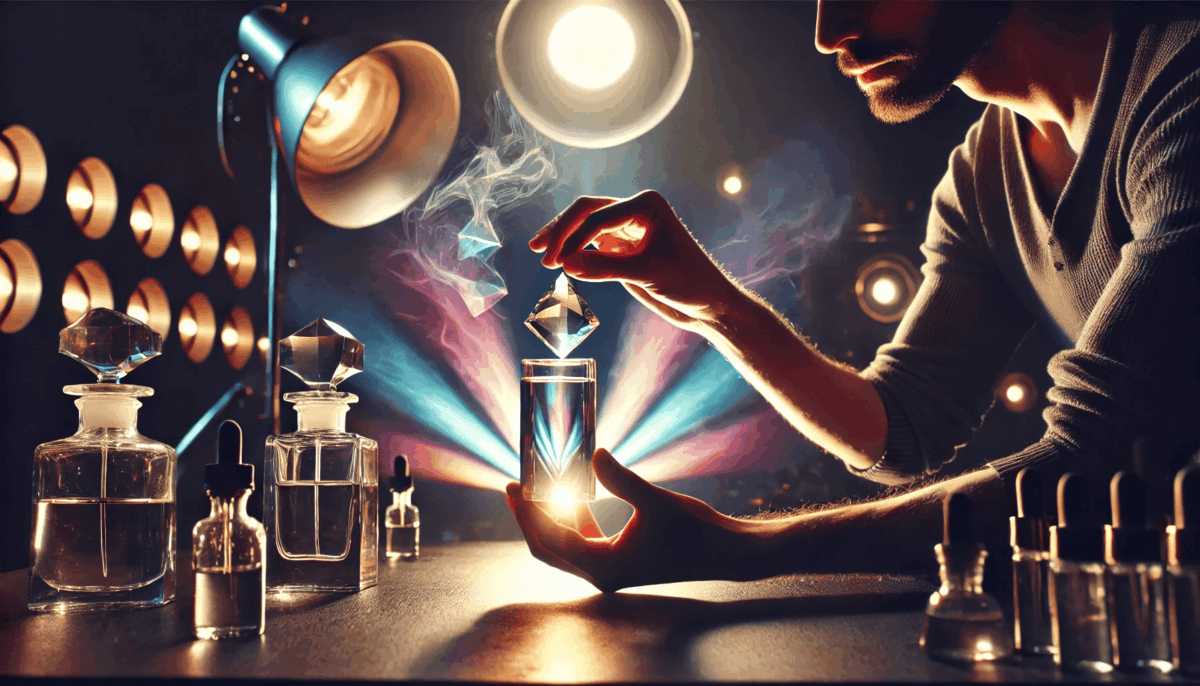The introduction of aldehydes into the perfumer’s toolkit marked a moment of transformation — a pivot as profound as adding a new primary color to a painter’s palette. Prior to their emergence, perfumery functioned largely as a mirror to nature, painstakingly reconstructing the delicate nuances of florals, woods, and resins. Aldehydes disrupted this tradition, offering synthetic molecules that had no direct botanical equivalent. Their sharp, luminous qualities opened doors to abstraction, allowing fragrance creators to craft scents that were more atmospheric than representational.
The defining moment came with Ernest Beaux’s revolutionary composition for Coco Chanel in 1921. Rather than imitating a single flower, he built a multilayered structure—a fragrance that evoked sensation more than substance. This was the dawn of conceptual perfumery, where emotions and impressions supplanted floral mimicry. It was here, amid this radical rethinking of what perfume could be, that aldehydes found their true voice. Their shimmering, airy brightness offered not just a new note, but a new language — a sensory cartography of the abstract and the real.
The arrival of aldehydes signaled a profound shift in how scent was experienced and understood. Audiences were first startled, then enchanted, by fragrances that seemed to float above the familiar. These molecules not only introduced new tonalities; they changed the architecture of perfume itself. In their wake followed generations of perfumers empowered to chase moods, seasons, and memories rather than single blooms. Aldehydes did not merely enhance compositions—they redefined them.
The legacy they left behind is a testament to the transformative power of chemistry in art. Today, the modern fragrance landscape is shaped as much by conceptual ambition as by raw ingredients. The rise of aldehydes is not just the story of a molecule—it’s the story of how innovation reshaped an entire creative field and made room for the invisible to be both imagined and deeply felt.
The Architecture of an Abstract Scent
Aldehydes are organic compounds characterized by a carbonyl functional group, where a carbon atom is double-bonded to an oxygen atom. What makes them distinct is that this carbonyl group is located at the end of a carbon chain. This specific molecular structure is the source of their unique and potent aromatic properties, which can range from waxy and citrusy to metallic and soapy. Their power lies in their volatility and their ability to “lift” and brighten other notes within a composition.
While aldehydes do exist in nature—in citrus rinds, rose, and pine, for example—the ones that revolutionized perfumery were largely aliphatic, or “fatty,” aldehydes synthesized in a lab. This synthetic origin is key to their abstract quality, as they could be produced in pure forms and precise concentrations that do not occur naturally. This gave perfumers an unprecedented level of control, allowing them to construct entirely new olfactory architectures. The resulting scents felt futuristic and intentionally man-made, a stark contrast to the familiar comfort of natural bouquets.
The perceived scent of an aldehyde is directly linked to the length of its carbon chain, a principle that perfumers manipulate with scientific precision. Shorter-chain aldehydes might be sharp and green, while longer ones (from C-8 to C-12) unveil the more complex, waxy-floral, and sparkling effects cherished by creators. This relationship between chemical structure and sensory output allows for a calculated approach to achieving specific textural effects. It is this blend of art and chemistry that makes working with aldehydes both a challenge and a thrilling creative endeavor.
A Perfumer’s Chemical Alphabet
The classification of aldehydes in perfumery is primarily based on the number of carbon atoms in their molecular chain, which directly correlates to their scent profile. This systematic organization allows perfumers to select a specific aldehyde to achieve a desired effect, much like a musician choosing a particular instrument for its timbre. Understanding this classification is essential to appreciating the technical skill behind many iconic fragrances. The most famous “aldehydic explosion” in Chanel No. 5 was not one single ingredient, but a masterful overdose of a specific blend.
This methodical approach gives structure to an otherwise abstract family of scents, providing a predictable framework for creative exploration. Each aldehyde offers a unique contribution, from adding a subtle shimmer to creating a dominant, diffusive aura that defines the entire character of a perfume. The art lies in balancing their power, as their potency can easily overwhelm a composition if not handled with expertise and restraint. They are the high-voltage wires of perfumery: dangerous if mishandled, but capable of illuminating everything.
Perfumers commonly work with a specific range of aliphatic aldehydes, each known by its carbon count and distinctive character:
- Aldehyde C-10 (Decanal): Possesses a sharp, waxy, and distinctly orange-peel scent, often used to impart a powerful citrusy freshness.
- Aldehyde C-11 (Undecanal): Provides a clean, “freshly-ironed linen” effect with a unique floral-waxy undertone.
- Aldehyde C-12 (Dodecanal): Known for its complex profile that combines lily, violet, and a diffusive soapy quality, it is a cornerstone of the classic aldehydic floral genre.
Engineering a Multi-Sensory Experience
The perceptual impact of aldehydes extends far beyond their primary scent, tapping directly into the brain’s associative and emotional centers. Their abstract nature forces our minds to create new connections rather than relying on pre-existing scent memories like “rose” or “sandalwood.” This blank-slate quality is what gives aldehydic fragrances their signature intellectual and sophisticated character. They don’t just smell pleasant; they spark curiosity and command attention on a cognitive level.
This mechanism is why aldehydes are often described using textural or visual metaphors: “sparkling,” “frosty,” “starchy,” or “metallic.” These are not smells in the traditional sense, but rather multi-sensory experiences triggered by a single class of molecules. The brain, unable to file the scent under a familiar category, interprets the sharp, vibrating sensation as a physical or visual quality. It is a form of synesthesia engineered in a bottle, transforming the act of smelling into something more complex.
The use of aldehydes can also manipulate our perception of a fragrance’s other components, making florals seem more luminous or woods feel cleaner. They act as an olfactory spotlight, highlighting certain facets of a composition while casting others in shadow. This ability to modify and enhance is what makes them an indispensable tool for creating dynamic, evolving scents. Their presence ensures that the fragrance journey is never static, but full of unexpected turns and revelations.
The Modern Evolution: From Icon to Accent
Since their groundbreaking debut, the role of aldehydes has evolved significantly, adapting to changing tastes and technological advancements. While the powerful, soapy character of classic aldehydic florals remains iconic, contemporary perfumers now use these molecules with more subtlety and precision. Instead of being the dominant star of the show, they are often employed as a supporting actor to introduce a specific texture or a moment of unexpected brightness. This shift reflects a move towards more nuanced and wearable fragrance structures.
Modern chemistry has also expanded the perfumer’s toolkit far beyond the classic C-10 to C-12 chain, introducing new aldehydes with unparalleled potency and unique profiles. These next-generation molecules allow for the creation of hyper-realistic water, metal, or ozone effects that were previously unattainable. The innovation is constant, pushing the boundaries of what a perfume can express and the stories it can tell. This ensures aldehydes remain perpetually relevant in the landscape of scent.
Ultimately, the journey of aldehydes from a shocking novelty to an integral part of the perfumer’s craft showcases their remarkable versatility. They can be dosed high for a bold, retro-glamour statement or micro-dosed to add a sophisticated, modern shimmer to a composition. This adaptability guarantees their place in the future of perfumery, continuing to inspire creators to build new olfactory worlds. Their story is a powerful reminder that sometimes, the most artificial ingredients can evoke the most profound emotions.
Frequently Asked Questions
This association comes primarily from Aldehyde C-12 (Dodecanal), a key ingredient in many early 20th-century fragrances and, concurrently, luxury soap formulations. Its specific waxy-floral scent profile became synonymous with the smell of high-end soap, creating a powerful cultural and sensory link that persists to this day. The brain identifies that specific note and connects it to the established memory of “cleanliness” and “lather.”
Not directly. Longevity in a perfume is primarily determined by the molecular weight and volatility of its base notes (like resins, woods, and musks). Aldehydes are highly volatile top and middle notes, meaning they evaporate relatively quickly. However, their powerful diffusive quality can create the perception of a stronger, more present fragrance in the initial hours of wear, making the scent feel more potent and impactful.
Yes, when used within the strict safety guidelines established by regulatory bodies like the International Fragrance Association (IFRA). Perfumers use aldehydes in very small, highly diluted concentrations that are deemed safe for cosmetic application. Like any fragrance ingredient, natural or synthetic, a very small percentage of the population may have a sensitivity, but for the vast majority of people, they are perfectly safe.

